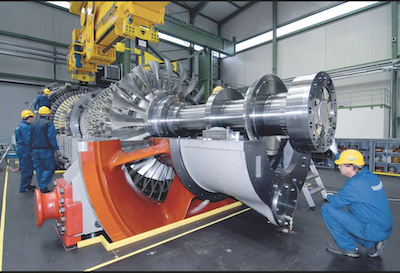South Korea pivots to gas
4 May 2022And embraces H class technologies.

Image: The Anyang CHP site
GE has announced the start of commercial operation of GS Power’s Anyang unit 2-2 combined heat and power plant in Anyang City, Gyeonggi Province, South Korea. The project has consisted of “the renewal of older gas-powered assets with the latest turbine technology”, says GE, including a GE 7HA.02 gas turbine equipped with GT H65 generator, plus an STF D650 steam turbine with ST A39 generator. The GE scope also included a Mark VIe distributed control system (DCS) and “services to support the availability and reliability of the plant.”
The updated plant has an installed capacity of about 500 MWe, while also providing steam for district heating to more than 180 000 residents of Anyang City. Construction challenges included the pandemic and extraordinarily heavy rains and typhoons, but the plant achieved commercial operation one week ahead of schedule. This is attributed to the use of a modularised construction process – where large parts of the plant were manufactured and shipped already assembled to the construction site – and successful collaboration between GE, GS Power and FieldCore, GE’s field services company.
GE’s HA technology is capable of reaching close to 62.2% net plant efficiency in combined cycle and more than 93% efficiency in district heating mode.
“Following GE’s successful modernisation of Anyang CHP unit 2-1”, GS Power says it chose to continue to partner with GE on the second- unit renewal project and notes that “this project is also contributing towards the country’s goal laid out in the government’s Green New Deal to achieve carbon neutrality by 2050.”
It is estimated that modernisation of the Anyang CHP plant has increased electrical generation by 13.8 percentage points.
Similarly to the Naepo and Kospo (Korea Southern Power Co) district heating projects, the Anyang CHP plant is being connected to Korea’s Direct Heating System (DHS), a centralised system which has been distributing heat to residential developments since the 1990s.
“Gas power plays a critical role in facilitating South Korea’s transition to a more energy efficient, reliable, and lower carbon future”, said Ramesh Singaram, president & CEO, GE Gas Power Asia. “Since Korea’s long-term goal is to increase its reliance on renewable power sources, gas turbine technology is crucial to ensure the needed power is available to balance the variable nature of renewables and ensure system reliability at all times.”
GE’s previous experience with district heating CHP in Korea includes not only Anyang 2-1, but also the Naepo CHP plant (Naepo City), Kospo’s Shinsejong CHP plant in Sejong City, and the Oseong CHP plant in Pyeongtaek.
The GE gas turbine fleet in South Korea consists of more than 77 units (in simple and combined cycle), with a capacity of 14 GW. In 2015, GE undertook what it describes as “a large-scale manufacturing plant investment”, in Changwon, South Korea, by acquiring Doosan’s HRSG business.
Further order for Siemens HL
Meanwhile, Siemens Energy has received another order to deliver HL-class power plant equipment to South Korea. It will be used in the Eumseong unit 1 single-shaft combined cycle power plant, to be built at Eumseong in north western Chungcheongbuk-do province. The order has been received from Korea East-West Power Co, a subsidiary of South Korea’s state-owned utility Korea Electric Power Corp. (KEPCO). It is Siemens Energy’s seventh HL-class gas turbine order from South Korea.

Above: Siemens Energy H class gas turbine
The new combined cycle plant at Eumseong, to be commissioned in late 2024, will be built instead of a previously planned 1000 MW coal-fired power plant that was cancelled following a change in the South Korean government’s environmental policy.
The new plant will operate on re-gasified liquefied natural gas (LNG). The switch to gas combined cycle is estimated to reduce CO2 emissions by as much as 3.7 million tons per year compared to a similar coal power plant, Siemens estimates.
Eumseong unit 1, the first of two planned combined cycle units at the site, will have an installed capacity of 571 MWe.
Siemens Energy’s scope of supply includes a SGT6-9000HL gas turbine, a SST-5000 steam turbine, a SGen-3000W generator, and an SPPA-T3000 control system.
The order also includes a long-term part management contract for the gas turbine, technical field advisory services, and digital services including diagnostics services, continuous performance optimisation, and compressor condition performance- monitoring, which will “improve asset utilisation, reliability, and availability while also reducing operating and maintenance costs.”
EPC specialist POSCO E&C, which has completed numerous projects with Siemens Energy in South Korea in the past, will be responsible for constructing the plant. “Thanks to its ergonomic design and architecture, the power plant has a compact footprint and fits very well into its surroundings", says Siemens.

